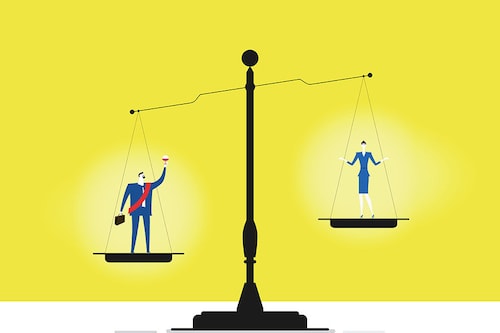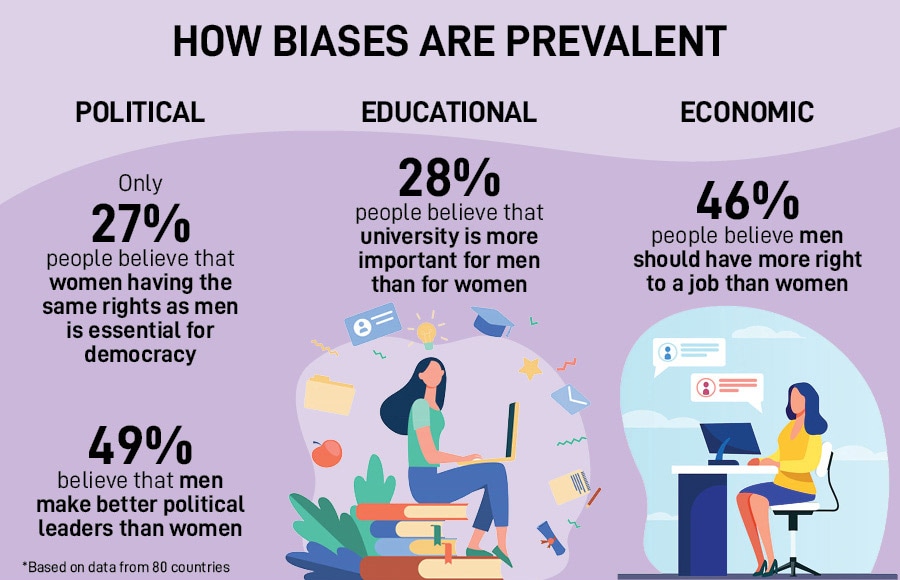Gender equality still a far cry: report
Findings from the 2023 GSNI report indicate that despite progress in fundamental areas, gender equality is still some distance away


Is the world on track to achieve gender equality by 2030? The answer is a resounding no, if the 2023 Gender Social Norms Index (GSNI) report is anything to go by. The UNDP’s composite measure of gender inequality in empowerment, the global Gender Inequality Index (GII), has remained stagnant since 2019. Although significant advancements have been made for women across the world in various fundamental areas, such as gaining the right to vote and attaining equal access to education, progress has been slow in terms of empowering women and amplifying their voices. Women continue to be underrepresented in positions of leadership, ranging from corporate boardrooms to presidential cabinets.
Why is that? “Partly because of biased gender social norms—the undervaluation of women’s capabilities and rights in society," says the report. It outlines shocking figures such as nine out of 10 men and women hold biases against women only 28 percent of managerial positions worldwide are held by women 28 percent people believe that university is more important for men than for women, etc (see graphics).
“One of the statistics that really jumped out at me from this report was that almost 46 percent of people who were surveyed said men have more right to a job than a woman. This is significant because it shows you how far we still have to go to achieve parity, particularly in the economic domain," says Mitali Nikore, an economist and gender policy specialist. She feels that such a perspective leads one to think they have greater right to a promotion, to make better business decisions and so on. “All of these accumulate to result in the gender wage gap."
The Sustainable Development Goals (SDGs) reflect the fact that “biased gender social norms are a major impediment to achieving gender equality and empowering all women and girls". Recent findings by the GSNI and the Human Development Index (HDI) indicate a disconnect between women"s educational opportunities and their economic empowerment. At present, the disparity in average income between women and men is more closely associated with prevailing gender norms than the differences in education levels. In countries where gender norms exhibit greater bias, women dedicate significantly more time, up to six times as much, to domestic chores and caregiving responsibilities compared to men. 
“Over centuries, the messages a woman receives as a child from her family, and socially, is to be prepared to be a dutiful wife and caring mother whereas her brothers are encouraged to join the business or start out as entrepreneurs," Meher Pudumjee, chairperson, Thermax, had told Forbes India in a previous interview.
According to current trends by the World Economic Forum (WEF), it is projected that the global gender gap will persist for another 131 years, which is about 30 percent longer than what was predicted by WEF in 2020. Although there has been significant economic progress for women following the decline of the Covid-19 pandemic, the journey towards achieving gender equality in political and educational spheres has experienced setbacks. The estimated time required to bridge the political gender gap has increased for the third consecutive year and is now projected to be 162 years, as per the World Economic Forum. Similarly, while advancements have been made, educational parity is expected to take 16 more years, a decrease from 2022 but still an increase from 2020 and 2021. 
Among nations evaluated based on economic participation and opportunity, educational attainment, health and survival, and political empowerment, Scandinavian countries have made significant strides towards closing the gender gap. On the other hand, India ranks quite low at 127 out of 146, largely due to the substantial gaps in economic participation and one of the largest disparities in health and survival for women and girls, as indicated by the trends report.
The GSNI report indicates that in order to promote and advance gender equality, our efforts should concentrate on expanding human development through investments, insurance, and innovation. By prioritising education, recognition, and representation, we can directly challenge and address the biases embedded in gender social norms.
“If we combine this report and the many data points in India around education for women, harassment against women, and work opportunities for women, we can see a full picture of bias emerging, which shows change is happening but it"s slow. I think the government can really break that cycle and create more job opportunities for women, particularly for women entrepreneurs to expedite the change," says Nikore.
First Published: Jun 28, 2023, 14:09
Subscribe Now